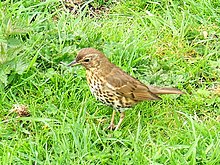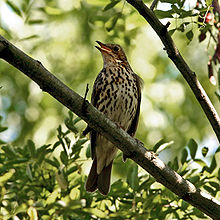欧歌鸫
| 欧歌鸫 | |
|---|---|

| |
| 科学分类 | |
| 界: | 动物界 Animalia |
| 门: | 脊索动物门 Chordata |
| 纲: | 鸟纲 Aves |
| 目: | 雀形目 Passeriformes |
| 科: | 鸫科 Turdidae |
| 属: | 鸫属 Turdus |
| 种: | 欧歌鸫 T. philomelos
|
| 二名法 | |
| Turdus philomelos Brehm, 1831
| |

| |
欧歌鸫(学名:Turdus philomelos)是一种分布在欧亚大陆的鸫属鸟类,上身呈褪色,下身呈奶白色或浅黄色,有黑色斑点。它们歌声独特,常见于诗歌。
欧歌鸫在森林、花园和公园繁殖。它们会在树上以泥筑巢,每次会生4-5颗蛋。它们是杂食性的,懂得利用石头作为铁砧攻击蜗牛。它们就像其他雀形目般受体内、外的寄生虫侵袭,且易被猫和猛禽捕食。
有一部分的欧歌鸫是候鸟,会飞到南欧、北非及中东过冬。它们也有被引进到新西兰及澳洲。它们虽然并非濒危,但在欧洲部分地区的数量大幅减少,可能是与种植业的改变有关。
科学分类[编辑]
命名[编辑]
欧歌鸫见于德国鸟类学家Christian Ludwig Brehm1831年的记载,其原学名一直沿用至今。[2]种小名是以希腊神话中的公主菲洛墨拉来命名,菲洛墨拉的舌头被割下但却变成了一只会唱歌的鸟。[3]
分类[编辑]
分子研究显示欧歌鸫是槲鸫及宝兴歌鸫的近亲。这三种是鸫属早期的分支,分支出来的时间比它们多样化及扩散全球还要早,故与乌鸫较为疏远。[4]

欧歌鸫其下有三个亚种:
- 指名亚种(T. p. philomelos):占了大部分的分布地;
- T. p. hebridensis:由英国鸟类学家William Eagle Clarke于1913年描述。它们是一种留鸟,分布在苏格兰的埃利安锡尔及斯凯岛。它们的颜色最为深色,背部呈深褐色,臀部灰色,上身淡浅黄色,两侧呈灰色。[5]
- T. p. clarkei:是由德国动物学家Ernst Hartert于1909年描述。它们分布在英国及爱尔兰,并在法国、比利时及荷兰,有可能也在更东的地区。它们上身呈褐色,色泽较暖,臀部呈橄榄色,下身呈黄色。它们是部分候鸟,一些会到法国南部及伊比利半岛过冬。它们可以与在中欧的指名亚种及在内赫布里底群岛的T. p. hebridensis混种。[5]
另一个亚种,如西伯利亚的T. p. nataliae并未广泛获得接受。[5]
特征[编辑]

欧歌鸫长20-23.5厘米及重50-107克。两性相似,背部呈褐色,下身呈奶白色或浅黄色,有黑色的斑点。翼底及喙呈黄色,脚是粉红色的。它们上身的颜色由瑞典至西伯利亚逐渐变冷色系。雏鸟像成鸟,但背上及翼底有浅黄色或橙色的斑纹。[5]
最像欧歌鸫的物种是白眉歌鸫,但它们的眉是白色,两侧红色。槲鸫较大,尾巴呈白色;宝兴歌鸫虽然羽毛相似,但面上有黑色斑纹,而且分布地也不重叠。[5]
欧歌鸫的叫声短而尖锐,迁徙时会发出薄而高音的叫声。警报声会随着危险而变得短及刺耳。雄鸟在树上、天台或其他高位的叫声是清晰的歌声。在埃利安锡尔的群落一般会在2月至6月间发出这种叫声,而其他亚种则要到11月至7月才发出这种叫声。[5]它们是叫声最大的鸟类之一。[6]
雄鸟的歌声可以多达100种剧目[7],大部分都是由父母处及邻近的鸟类抄来。模仿声包括人造的电话声[8],它们也会重复饲养鸟类的叫声,如白脸树鸭。[5]
分布及栖息地[编辑]

欧歌鸫在大部分欧洲地区(但不包括大部分伊比利半岛、意大利低地或希腊南部)、经乌克兰及俄罗斯至贝加尔湖繁殖。它们在挪威分布至北纬75°,但在西伯利亚却只达北纬60°。从斯堪的纳维亚、东欧及俄罗斯而来的欧歌鸫会到地中海、北非及中东过冬,但在西部的只有一些会离开自己的地方。[5]
指名亚种于1860年及1880年由驯化协会引入到新西兰及澳洲。[9]欧歌鸫在新西兰快速适应及扩展至周边的岛屿,如克马德克群岛、查塔姆群岛及奥克兰群岛。[10]不过它们在澳洲只限于在墨尔本附近的地方。[11]欧歌鸫在新西兰掠食无脊椎动物造成一定影响[12],而它们也对果园造成商业损失。[13]欧歌鸫在新西兰作为入侵物种,故没有法律保障。[14]
欧歌鸫一般栖息在有草丛及邻近开放地方的森林,而在西欧则也会栖息在花园及公园。它们可以在林木线繁殖,在瑞士就可达2200米。T. p. hebridensis会在较为开放的郊野繁殖,包括荒原;而在东部的指名亚种则只限于茂密的针叶林内繁殖。[5]英国一项研究发现欧歌鸫的分布地只有3.5%是农地,而花园则占了71.5%。余下的则是林地。[15]它们过冬的地方与繁殖地相近,但不会在高原及其他开放的地方。[16]不过T. p. hebridensis会经常走到海岸过冬。[5]
行为[编辑]
欧歌鸫并不经常聚居,有时在冬天或环境适合觅食时才会走在一起,也有可能与乌鸫、田鸫或白眉歌鸫一起生活。[5]它们倾向回到同一过冬的地区。[16]
欧歌鸫是一夫一妻制的。在会迁徙的地区,雄鸟回到繁殖地后会重新设立地盘及开始唱歌;而在其他地区,雄鸟会全年留在自己的地盘,间中唱歌,但雌鸟可能会自行设立过冬的地点,直至于初春时配对在一起。[16]
在迁徙时,欧歌鸫主要在夜间展开旅程,并采取直接及强烈的飞行行动。它们会以松散的小群横渡海洋,并经常互相呼叫保持联系。[5]在较北部的欧歌鸫会于4月至8月进行迁徙,而大部分的因路程较短,则会在9月至12月中旬才南下。恶劣的气候可以使它们迁徙得更远。回程的时间各有不同,如在地中海的是约在2月中旬,而瑞典北部及西伯利亚中部的则会在5月。[5]在格陵兰、多个大西洋岛屿及西非曾发现一些离群的份子。[5]
繁殖及生存[编辑]

雌性欧歌鸫会在灌木、树或蔓上筑巢,T. p. hebridensis则会在地上筑巢。它们会以泥及干草筑巢。雌鸟每次会生4-5颗蛋,鸟蛋呈鲜蓝色,有些少黑色或紫色的斑点[5],蛋约有2.7 x 2.0厘米大小及重6克,当中6%为蛋壳。[3]雌鸟会独自孵蛋10-17日;孵化后10-17日雏鸟就会换羽。它们每年一般生2-3次蛋,但在北部地区的可能只有一只雏鸟能仍长。[5]平均而言,54.6%的英国雏鸟于首年仍然生存,成年的每年生存率为62.2%。它们的寿命为3年,但最老的可以老达10岁8个月。[3]

欧歌鸫有时会成为大杜鹃等的寄主,但此情况很罕有,因它们能够发现杜鹃鸟蛋的不同。[17]不过,它们不会带有与乌鸫相同的攻击性对付成年杜鹃。[18]在新西兰入侵的欧歌鸫在以往超过130年间都能分辨非伪装的鸟蛋。[19]
猫、纵纹腹小鸮及雀鹰等会掠食成年欧歌鸫;喜鹊、松鸦及灰松鼠也会掠食鸟蛋及雏鸟。[20][21][22]就像其他的雀形目,欧歌鸫也有寄生虫,如线虫动物门的Splendidofilaria (Avifilaria) mavis。[23]一项俄罗斯有关血液寄生虫的研究显示所有田鸫、白眉歌鸫及欧歌鸫含有变形血原虫属及锥虫属。[24]硬蜱属也很普遍,它们也会带有病原体,包括在俄罗斯、东欧及中欧森林地区的脑炎[25],与及较为普遍的疏螺旋体属。[26]一些疏螺旋体属的物种会引起莱姆病,而欧歌鸫等在地上觅食的雀鸟则是此病的温床。[27]
觅食[编辑]

欧歌鸫是杂食性的,吃多种无脊椎动物,尤其是蚯蚓及蜗牛,也会吃软果实及草莓。它们会以视觉来寻找猎物,或会在叶堆中寻找潜在食物。[5]
当在干旱或恶劣的环境下,蜗牛是欧歌鸫重要的食物。它们会用石头来敲碎蜗牛的壳,抽出软体部分,并将之放在地上擦。[16]幼鸟最初会学习抛物件,直至懂得使用工具来敲碎蜗牛壳。[28]雏鸟主要吃动物食物,如蠕虫、蛞蝓、蜗牛及昆虫幼虫。[5]
二树丛蜗牛经常被欧歌鸫所掠食,它们多态的壳被认为是为了减低掠食而进化的。[29]不过,欧歌鸫并非唯一的掠食者。[30]
保育状况[编辑]
欧歌鸫的分布地很广,估计达1000万平方公里,单在欧洲的数量就估计有4000-7100万只。[1]
在古北界西部,有证据显示数量下降,但并未达至保育的水平,故世界自然保护联盟将之列为无危。[1]在英国及荷兰,它们的数量就下降了50%。[16][31]在农地上的数量下降得最厉害,相信是与种植业的改变有关。[32]真实原因但却不明,也有可能与树篱的消失或加剧使用杀虫剂有关。这种改变令食物的供应减少。[33]在花园,使用毒饵来控制蛞蝓及蜗牛也对欧歌鸫造成危害。[22]在城市,它们也成为了路杀。[34]
文化[编辑]
托马斯·哈代[35]、泰德·休斯[36]及威廉·华兹华斯[37]也在其诗中描述了欧歌鸫。
食物[编辑]
欧歌鸫最早于12000年前被捕猎作为食物[38],在《奥德赛》也有记载。[39]在地中海一直至今也有捕猎它们,但并非它们在某些地区真正减少的原因。[32]
在西班牙仍然有用粘鸟胶来捕捉欧歌鸫。[40]于2003年及2004年,欧盟尝试禁止这种捕猎方法,但不成功。[41][42]
宠物[编辑]
欧歌鸫最少于19世纪就已经被捕捉作为宠物。[43]同样地也没有证据显示捕捉它们作为宠物令其数量下降。[5]
参考[编辑]
- ^ 1.0 1.1 1.2 BirdLife International. Turdus philomelos. The IUCN Red List of Threatened Species 2004. [2006-05-12].
- ^ (德文)Brehm, Christian. Handbuch der Naturgeschichte aller Vogel Deutschlands. 1831: 382.
- ^ 3.0 3.1 3.2 Song Thrush Turdus philomelos [CL Brehm, 1831]. BTO Birdfacts. British Trust for Ornithology. [2008-01-25]. (原始内容存档于2013-04-01).
- ^ Voelker G, Rohwer S, Bowie RCK, Outlaw DC. Molecular systematics of a speciose, cosmopolitan songbird genus: Defining the limits of, and relationships among, the Turdus thrushes. Molecular Phylogenetics and Evolution. 2007, 42 (2): 422–34. PMID 16971142. doi:10.1016/j.ympev.2006.07.016.
- ^ 5.00 5.01 5.02 5.03 5.04 5.05 5.06 5.07 5.08 5.09 5.10 5.11 5.12 5.13 5.14 5.15 5.16 5.17 5.18 Clement, Peter; Hathway, Ren; Wilczur, Jan. Thrushes (Helm Identification Guides). Christopher Helm Publishers Ltd. 2000: 392–5. ISBN 0-7136-3940-7.
- ^ Brackenbury, J. H. Power capabilities of the avian sound-producing system (PDF). J. Exp. Biology. 1979, 78: 163–6 [2010-07-02]. (原始内容存档 (PDF)于2008-10-10).
- ^ Devoogd, Timothy J.; John R. Krebs, Susan D. Healy, Andy Purvis. Relations between Song Repertoire Size and the Volume of Brain Nuclei Related to Song: Comparative Evolutionary Analyses amongst Oscine Birds.. Proceedings: Biological Sciences. 1993, 254 (1340): 75–82. doi:10.1098/rspb.1993.0129.
- ^ Slater, Peter J. B. The Buzby phenomenon: Thrushes and telephones. Animal Behavior. 1983, 31: 308–309. doi:10.1016/S0003-3472(83)80204-8.
- ^ 'BIRDS', from An Encyclopaedia of New Zealand, edited by A. H. McLintock, originally published in 1966. Te Ara - The Encyclopedia of New Zealand, updated 18-Sep-2007. Ministry for Culture and Heritage / Te Manatū Taonga. [2008-03-13]. (原始内容存档于2008-09-07).
- ^ Heather, B.; Robertson, H. The Field Guide to the Birds of New Zealand. Auckland: Viking. 1996: 384–5. ISBN 0-670-89370-6.
- ^ Song thrush (Turdus philomelos). Birds. Department of Agriculture, Western Australia. [2008-01-25]. (原始内容存档于2007-12-08).
- ^ The State of Our Invertebrate Animals. State of New Zealand's Environment 1997, Chapter 9. Ministry for the Environment, New Zealand. [2008-03-13]. (原始内容存档于2008-06-17).
- ^ Song thrush (Turdus philomelos). Department of Agriculture and Food Western Australia. [2008-03-13]. (原始内容存档于2007-12-08).
- ^ The State of Our Indigenous Birds (PDF). The State of Our Biodiversity - The State of New Zealand’s Environment. Ministry for the Environment, New Zealand. [2008-03-13]. (原始内容 (PDF)存档于2015-01-24).
- ^ Mason, Christopher F. Habitats of the Song Thrush Turdus philomelos in a largely arable landscape. Journal of Zoology. 1998, 244: 89–93. doi:10.1111/j.1469-7998.1998.tb00010.x.
- ^ 16.0 16.1 16.2 16.3 16.4 Snow, David; Perrins, Christopher M (editors). The Birds of the Western Palearctic concise edition (2 volumes). Oxford: Oxford University Press. 1998: 1225–8. ISBN 0-19-854099-X.
- ^ Davies, N. B. Cuckoo tricks with eggs and chicks. British Birds. March 2002, 95 (3): 101–15.
- ^ Grim, Tomáŝ; Honza, Marcel. Differences in behaviour of closely related thrushes (Turdus philomelos and T. merula) to experimental parasitism by the common cuckoo Cuculus canorus (PDF). Biologia, Bratislava. 2001, 56 (5): 549–56 [2018-09-13]. (原始内容 (PDF)存档于2017-08-09).
- ^ Hale, Katrina & Briskie, James V. Response of introduced European birds in New Zealand to experimental brood parasitism. Journal of Avian Biology. 2007-11-06, 38 (2): 198–204 [2010-07-02]. doi:10.1111/j.2007.0908-8857.03734.x. (原始内容存档于2022-10-17) (英语).
- ^ Brown, Roy. A Review of the impact of Mammalian Predators on Farm Songbird Population Dynamics (PDF). Songbird Survival. [2008-01-27]. (原始内容 (PDF)存档于2007-07-02).
- ^ Song thrush. Birds and wildlife. RSPB. [2008-01-27]. (原始内容存档于2009-04-26).
- ^ 22.0 22.1 Song thrush - Turdus philomelos. Gardening with Wildlife in Mind. Natural England. [2008-01-28]. (原始内容存档于2009-08-15).
- ^ (西班牙文)Martil, S. Cano; Caballero, E.J. López; del Valle Portilla, María T. Estudio con microscopia electrónica de barrido de adultos de Splendidofilaria (Avifilaria) Mavis (Leiper, 1909) Anderson, 1961. (PDF). Revista biologia. 2000, 14 (1). (原始内容 (PDF)存档于2009-03-18).
- ^ Palinauskas, Vaidas; Markovets, Mikhail Yu; Kosarev, Vladislav V; Efremov, Vladislav D; Sokolov Leonid V; Valkiûnas, Gediminas. Occurrence of avian haematozoa in Ekaterinburg and Irkutsk districts of Russia (PDF). Ekologija. 2005, 4: 8–12. (原始内容 (PDF)存档于2009-03-26).
- ^ Fedorov, Yu. V. (1968) "Further observations on the significance of wild birds as hosts of Ixodes ticks in the Tomsk focus of tick-borne encephalitis" 互联网档案馆的存档,存档日期2009-02-25. Pentagon Reports Number: 0916176 (PDF)
- ^ Kipp, Susanne; Goedecke, Andreas; Dorn, Wolfram; Wilske, Bettina; VolkeFingerle. Role of birds in Thuringia, Germany, in the natural cycle of Borrelia burgdorferi sensu lato, the Lyme disease spirochaete. International Journal of Medical Microbiology. May 2006, 296: 125–8. PMID 16530003. doi:10.1016/j.ijmm.2006.01.001.
- ^ Comstedt, Pär; Bergström, Sven: Olsen, Björn; Garpmo, Ulf; Marjavaara, Lisette; Mejlon, Hans; Barbour, Alan G. and Bunikis, Jonas. Migratory Passerine Birds as Reservoirs of Lyme Borreliosis in Europe (PDF). Emerging Infectious Diseases. July 2006, 12 (7): 1087–94 [2010-07-02]. (原始内容 (PDF)存档于2010-10-11).
- ^ Henty, C. J. Development of snail-smashing by song thrushes. British Birds. 1986, 79: 277–81.
- ^ Goodhart, C. B. Thrush Predation on the Snail Cepaea hortensis. The Journal of Animal Ecology. May 1958, 27 (1): 47–57. doi:10.2307/2173.
- ^ Owen, Denis F.; Sven-Axel Bengtson. Polymorphism in the Land Snail Cepaea Hortensis in Iceland.. Oikos. 1972, 23 (2): 218–25. doi:10.2307/3543409.
- ^ Song Thrush Turdus philomelos. Breeding Birds in the Wider Countryside. British Trust for Ornithology/Joint Nature Conservation Committee. [2008-01-27]. (原始内容存档于2008-06-17).
- ^ 32.0 32.1 Cocker, Mark; Mabey, Richard. Birds Britannica. London: Chatto & Windus. 2005: 355–9. ISBN 0-7011-6907-9.
- ^ Song Thrush (Turdus philomelos). Species Action Plan. UK Biodiversity Action Plan. [2008-03-11]. (原始内容存档于2008-04-15).
- ^ Erritzoe, J.; Mazgajski T. D., Rejt L. Bird casualties on European roads — a review. (PDF). Acta Ornithol. 2003, 38: 77–93 [2010-07-02]. (原始内容存档 (PDF)于2017-08-09).
- ^ Stallings, A. E. The Darkling Thrush: A Centennial Appreciation. [2008-03-11]. (原始内容存档于2008-05-19).
- ^ Thrushes. Poems by Ted Hughes. Poemhunter. [2008-03-11]. (原始内容存档于2019-05-22).
- ^ The Tables Turned. William Wordsworth: Complete Poetical Works. bartleby.com. [2008-01-29]. (原始内容存档于2008-02-03).
- ^ Bocheñski, Z.; Tomek T. Bird remains from a rock-shelter in Krucza Skala (Central Poland) (PDF). Acta zooologica cracoviensia. 2004, 47 (1-2): 27–47 [2010-07-02]. (原始内容 (PDF)存档于2020-07-27).
- ^ Homer; Fagles, Robert (translator). The Odyssey. New York: Penguin Books. 1997: 453. ISBN 0-14-026886-3.
- ^ Commission of the European Communities. Failure of a Member State to fulfil obligations – Directive 79/409/EEC – Conservation of wild birds – Hunting using limed twigs - Summary of the Judgment. 9 December 2004 [2010-07-02]. (原始内容存档于2019-05-26).
- ^ (西班牙文)Las Provincias. Un entramado para cazar tordos. 14 December 2006 [2010-07-02]. (原始内容存档于2016-03-03).
- ^ (西班牙文)Europa Press. El Tribunal de la UE condena a España por permitir la caza con 'parany' en la Comunidad Valenciana. (原始内容存档于2008-06-14).
- ^ Dyson, C. E. Bird-Keeping - A Practical Guide for the Management of Singing and Cage Birds. Frederick Warne and co. 1889: 51.
外部链接[编辑]
| 维基物种上的相关信息:欧歌鸫 |
| 维基共享资源中相关的多媒体资源:欧歌鸫 |
- RSPB (页面存档备份,存于互联网档案馆)
- BBC Archive.is的存档,存档日期2012-12-23
- Birds of Britain (页面存档备份,存于互联网档案馆)
- Garden Birds (页面存档备份,存于互联网档案馆)
- Internet Bird Collection (页面存档备份,存于互联网档案馆)
|


